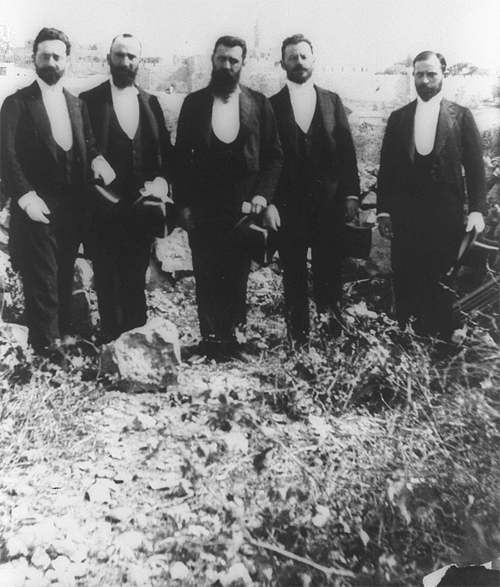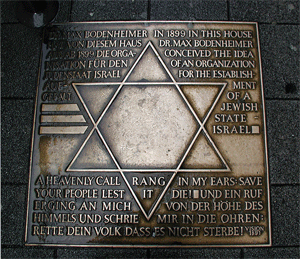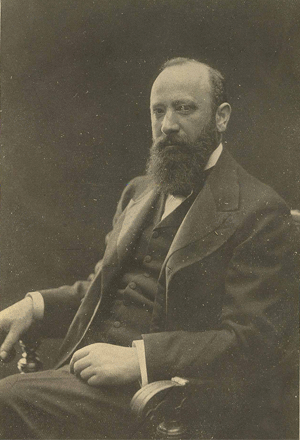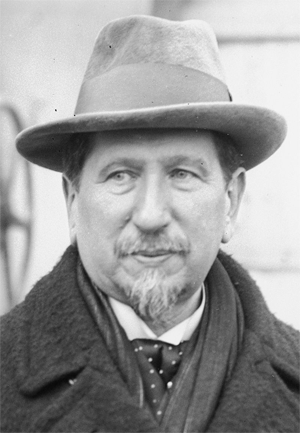by Wikipedia
Accessed: 11/14/18
NOTICE: THIS WORK MAY BE PROTECTED BY COPYRIGHT
YOU ARE REQUIRED TO READ THE COPYRIGHT NOTICE AT THIS LINK BEFORE YOU READ THE FOLLOWING WORK, THAT IS AVAILABLE SOLELY FOR PRIVATE STUDY, SCHOLARSHIP OR RESEARCH PURSUANT TO 17 U.S.C. SECTION 107 AND 108. IN THE EVENT THAT THE LIBRARY DETERMINES THAT UNLAWFUL COPYING OF THIS WORK HAS OCCURRED, THE LIBRARY HAS THE RIGHT TO BLOCK THE I.P. ADDRESS AT WHICH THE UNLAWFUL COPYING APPEARED TO HAVE OCCURRED. THANK YOU FOR RESPECTING THE RIGHTS OF COPYRIGHT OWNERS.
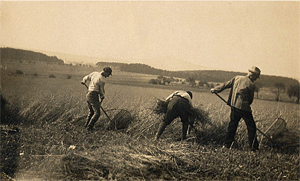
Work on the Hachschara farm in Betzenrod, Germany, 1920s
As Hachschara ( Hebrew הכשרה"Preparation, Appropriation") was the systematic preparation of Jews for the aliyah, d. H. for the colonization of Palestine especially in the 1920s and 1930s. Ideological basis for this program was the Zionism, it was carried and propagated by the Jewish youth movement, and here especially by the two umbrella organizations Hechaluz and Bachad.
Most Hachschara courses took place on agricultural goods. A group of emigrants (Hebrew קבוצה, Kəvutza) got there together what appeared necessary to build a community in Palestine. The young people, who often come from middle-class surroundings, mainly acquired horticultural, agricultural, domestic and craft skills and learned Iwrit, modern Hebrew. In the further development of the Hachschara, the creation of a Jewish identity became increasingly important. This included celebrating Jewish festivals, getting to know Jewish history and literature. Living and working in a collective should create the cultural basis for the new existence in Palestine. In later Israel , the Hachshara communities settled in the kibbutzim. Individuals who are willing to emigrate have rarely become acquainted with a farmer or craftsman.
History
The Hachshara formed at the end of the 19th century from the "Chaluzbewegung" (from Hebrew חלוץ, Chaluz, German pioneer), especially among Jews in the US and Russia. At the 12th Zionist Congress in 1922 in Karlovy Vary, the world pioneer organization Hechaluz was formed. In 1923, a German Hechaluz Association was founded, which in 1928 counted 500 members and four teaching goods. Overall, the movement among the strongly assimilated Jews of Western Europe spread only slowly. Only since the global economic crisis has emigration been understood by many as an opportunity for a new economic start. The idealistic attitude of early Zionism receded into the background.
The growing discrimination against the Jews gave the Hachschara movement a great deal of popularity in the early stages of National Socialist rule in Germany. In addition to the preparation for emigration to Palestine, it was especially important for young Jews that Hachschara was one of the last possibilities for them to obtain any vocational training (redeployment in the language at that time). In 1934, the German Hechaluz recorded around 15,000 members. Around 3,500 people were trained at the time in the Hachschara teaching facilities. These were commissioned by the Reichsvertretung der Deutschen Juden by Martin Gerson cared for. In total, at least 32 of these preparatory camps were set up within the then German borders.
In the early years, the predominant form of education was the single Hachscharain which people who wanted to leave the country worked for a farmer or a craft business and were supported and looked after by a Hachschara or Hechaluz center. With increasing demand for training places since 1933, other forms of Hachshara emerged, such as "Hachschara-Kibbuzim, where the youth lived and trained together, Hachschara centers where they lived together, but trained in various agricultural and craft trades Jobs were given and -- especially in larger cities -- the Batei-Chaluz (sing. Beit Chaluz), dormitories for young people willing to leave home with individual or domestic vocational training. The increased demand for training places explains only partially the accelerated expansion of the common Hachschara teaching materials in the following years,[1]
Hachshara and Youth Aliyah were important pillars of Jewish self-help in preparing young people for emigration to Palestine. In addition, in 1935, the so-called Mittler-Hachschara (also: Mi-Ha). It aimed at 15- to 17-year-olds and looked like the regular Hachschara a two-year agricultural, horticultural or domestic education. An apprenticeship took three years. [2] Joseph Walk refers to her as a substitute for not youth aliyah to Palestine immigrant youth of this age group. It "follows in its daily routine the model of the groups educated in the collective settlements there: the morning was the professional, essentially agricultural (for girls: domestic) training, the afternoon reserved for spiritual training. The curriculum included Hebrew (6 hours), Judaism and Judaism (2), Geography (2), Science (2); one hour each of Palestine and Zionism. The discussions and discussions that took place during the evenings on days off, which focused primarily on the problems of Palestinian construction, took up a great deal of space.[3]
As bearer of the Mi-Ha, Walk also mentions the Noar Agudati ("Youth of the Aguda") in addition to the already mentioned associations Hechaluz and Bachad. It was the German youth association of the founded in 1912 ultra-Orthodox-Jewish Agudath Israel World Organization. An important role in this organization played Kalman Kahana, who was involved in the founding of the Noar Agudati in Germany. [4]
A special role played the foreign Hachschara. It existed in ten European countries in the 1930s, predominantly in the form of the single Hachschara. Only the Werkdorp Wieringermeer in Holland was organized in the style of a Hachschara kibbutz. The foreign Hachschara also offered the possibility to deprive particularly vulnerable persons from access by National Socialist authorities. There were also Youth Aliyah centers abroad, such as the boarding school Kristinehovin Sweden. They offered the opportunity to accommodate young people for whom there were no entry certificates for Palestine. In addition to the facilities already mentioned, there were those in Romania, Lithuania, Northern Ireland, England, France, Luxembourg, Denmark, Russia and Switzerland, as well as overseas (USA, Canada), where the origin of the movement lay.
Hachschara facilities
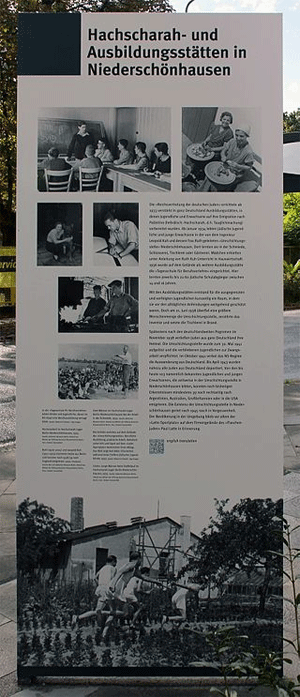
Memorial plaque, Selma-and-Paul-Latte-Platz, Berlin-Niederschönhausen
Hachschara institutions in the territory of the German Reich
Berlin
• The bottle factory of Selma Latte and Paul Latte in Berlin-Niederschönhausen, on whose grounds there was a Hachschara training company in handcraft. [5] The history of the former Hachsharah camp at the Buchholzerstraße 23-31 in Niederschönhausen exemplifies the self-assertion at risk of discrimination and exclusion Jewish population. [6]
Brandenburg
In Brandenburg, there were the following Hachshara sites [7]
• Old-Karbe in the Neumark, today Poland (existing until 1940)
• Landwerk Ahrensdorf near Trebbin (1936-1941) [8]
• Eichow »New field cutter mill«, today municipality Kolkwitz , with Cottbus (until 1941)
• Havelberg / Mark, Hunting Homestead Parola (until 1941)
• the agricultural estate of the copper and brass works Hirsch bei Eberswalde [9]
• Half in the marrow (until 1939)
• Hachschara camp Jessen (also Jessen mill ) near Sorau in the Lower Lusatia : "One of the few who survived underground until the liberation was the later TV presenter Hans Rosenthal, previously" on Hachschara "in Jessen in the Lower Lusatia." [ 10] (from 1937)
• Landkreis Neuendorf near Fürstenwalde (1932-1943)
• Polenzwerder at Eberswalde (1937 to presumably 1940)
• Rüdnitz, Hof Wecker, near Bernau (until 1941) [11] "In so-called Hachschara centers, the 14 to 17-year-old Jewish youth who enrolled in the Youth Aliyah to rely on Germany for Palestine were on her prepared there life. The Gut Rüdnitz on the railway line Berlin-Eberswalde was the first preparation center. It was followed, inter alia, Ahrensdorf at Trebbin, Schiebinchen (Sommerfeld / Niederlausitz), Polenzwerder at Eberswalde, Good angle at Fürstenwalde, kibbutz cracks near Hamburg, Kibbutz Jägerlust at Flensburg, Gehringshof at Fulda. There were also Youth Aliyah schools in Cologne and Berlin. " [12]
• Schniebinchen near Sommerfeld, today a part of the rural community Gmina Lubomino [13] (until 1941). The last two leaders of Schniebinchen , Alfred Cohn and Ludwig Kuttner, were previously teachers at the private forest school Kaliski in Berlin. [14]
• In the area of today's municipality Spreenhagen were several Hachschara facilities:
• Skaby (Kreis Beeskow) primarily for young couples (possibly until 1943)
• Landwerk Steckelsdorf near Rathenow [15] (1934-1942 / 43)
• Good angle [16]
Hamburg
In the Hamburg Hachschara facilities had until 1938 about 800 young people completed their education. [17]
• Agricultural school Shalom in Neugraben . [18] The school was an institution of Bachad.
• Youth hostel (Bet Chaluz) of the Hechaluz in Beneckestrasse (since June 1932). "The Bet Chaluz in the Beneckestraße became a center of Jewish youth culture - and a special goal of the November Pogrom in 1938." [17]
• Since June 1933 there were apprenticeships in a carpentry shop in Emilienstr. and in the Siedlerschule Wilhelminenhöhe. The latter was discontinued in the spring of 1934 because of its Zionist orientation and instead established a training course for gardeners. [17]
• For the care of the trainees, who were older than 18 years old, several care centers existed:
• Kibbutz Ejn Chaim ("Source of Life") in Hamburg cracks (from August 1933) [19]
• Kibbutz Schachal was an institution of Bachad in the former mansion of a Jewish dentist at Blankeneser Steubenweg 36 (now Grotiusweg 36) [20]
• Herut-Harut
• For mid-Hachschara participants, dormitories existed on Schäferkampsallee (from February 1936) and on Klosterallee (from May 1937).
• "Manual training offered the training workshops for carpenters and locksmiths in the Weidenallee, which had been established by the German-Israelite community in March 1934." [17]
• For girls, there have been training courses since March 1934 - mainly in practical housekeeping - "in the Jewish Household School in cooperation with the Jewish College for dressmakers (Heimhuderstr.), Internal in the boarding school of girls orphanage (Laufgraben)". [17]
• Since May 1935, the Bachad operated a religious school for girls in Johnsallee.
• Since February 1935, the Noar Agudati also operated a training center for girls in the Werderstraße.
Hesse
• Gehringshof near Fulda with its predecessors in Betzenrod (Scots) and Rodges ( Kibbutz Haddatih )
• Külte
Lower Saxony
• the - originally not Zionist - Israeli horticultural school Ahlem near Hannover
• Kibbutz Cheruth near Hameln [21] "In Hamelin the Hechaluz established a first common Hachschara site (Kibbutz-Hachschara) in 1926, most of them being members of the Zionist youth covenant 'Brith Haolim'. The name 'Cheruth' (freedom) was given by the group itself, but the reference to Buber's 'Cheruth' speech in 1919 is controversial. 1928 migrated the first of the group Cheruth 'and established together with Chaluzim from Eastern Europe Kibbutz Givat burner in Rehovot . " [22]
North Rhine-Westphalia
• Dietkirchener Hof in Urfeld
• Kibbutz Westerbeck - Hof Stern in Westerkappeln , Bauerschaft Westerbeck [23]
Schleswig-Holstein
• Brüderhof near Harksheide . He was probably looked after by the Hechaluz from Hamburg. "The Brüderhof ceased its work in the spring of 1939." [17]
Other Hachschara facilities
• A special feature was the so-called Nautical Hachschara of the " Fairplay Schleppdampfschiffs Reederei Richard Borchard GmbH " of the Jewish ship owner Lucy Borchardt . [24] "At the beginning of 1934, a maritime training of the Fairplay, later also the Amber and Schindler shipping companies had been added. It succeeded to accommodate a few apprentices in shipbuilding companies in Hamburg and Lübeck. They formed the human resource base of the resulting 1,934 merchant shipping in Palestine. " [17]
Forced Labor Instead of Hachschara
From 1941, the Hachschara institutions in the German Reich were converted by the National Socialists into forced labor camps for Jewish youth or completely dissolved.
Facilities of the foreign Hachschara
Great Britain
There were about 20 Hachschara centers across the UK.
• Whittingehame Farm School
• Millisle farm
• Not exclusively, but in parts, it is also possible to attribute the Camp Windermere to the foreign Hachshara, where young Holocaust survivors were cared for. According to Martin Gilbert, "consultants of various Zionist organizations, including Habonim and Hashomer Hatzair and the religious Zionist Bachad movement" took care of the young people there. [25]
Yugoslavia
• Subotica
At least between 1937 and 1939 there was a farm here "run by the Zionist organization Hechaluz. Here the young men and women learned to manage the winery and the fields, to take care of the animals and to run the farm. " [26]
Netherlands
• Werkdorp Wieringermeer
Sweden
• Boarding school Kristinehov
• Without mentioning further names, Pontus Rudberg refers to "young Jews who have completed their agricultural retraining on Swedish farms". [27]
Hachschara institutions after the Second World War
After the end of National Socialism, surviving Zionist Jews again founded Hachshara communities that existed until the establishment of the State of Israel in 1948.
• 30 institutions existed in Central and Upper Franconia. [28]
• The Gehringshof was reactivated as Kibbutz Buchenwald.
Literature
• Michael Winkelmann: The Hachscharah in Külte. In: Renate Knigge-Tesche, Axel Ulrich (ed.): Persecution and resistance in Hesse. 1933-1945. Eichborn, Frankfurt 1996, ISBN 3-8218-1735-6 , pp. 102-112.
• Irmgard Klönne, Ilana Michaeli (ed.): Good angle, the protective island. Hachshara 1933-1941. LIT publishing house, Berlin 2007, ISBN 978-3-8258-0441-1 .
• Werner Rosenstock: Exodus 1933 to 1939. An overview of Jewish emigration from Germany. In: Robert Weltsch (ed.): German Judaism, rise and crisis. Shapes, ideas, works. Fourteen monographs. Publication of the Leo Baeck Institute . Deutsche Verlagsanstalt , Stuttgart 1963, pp. 380-405 (first in English: Exodus 1933-1939, A survey of Jewish emigration from Germany, in: Leo Baeck Institute Yearbook LBY, 1, 1956, pp. 373-390; also as separate pressure)
• Ulrike Pilarczyk: Community in pictures. Jewish youth movement and Zionist educational practice in Germany and Palestine / Israel. (= Hamburg Contributions to the History of German Jews, Volume XXXV). Wallstein publishing house, Goettingen 2009, ISBN 978-3-8353-0439-0 . (on-line)
• Joseph Walk: Jewish School and Education in the Third Reich. Publisher Anton Hain, Frankfurt am Main 1991, ISBN 3-445-09930-8 .
Sources and Web Links
• Literature by and about Hachschara in the catalog of the German national library
• Hachschara site Ahrensdorf
• Hachshara in Brandenburg
• A Fürstenwalder story: Landwerk Neuendorf im Sande and Gut Winkel, Martin Gerson and Clara Grunwald (PDF 38 KB)
• Memorial Ahlem on the site of the former "Israeli horticultural school Ahlem"
• The training center of the Hechaluz on the Brüderhof near Harksheide, haGalil , by Sieghard Bußenius
• with list of Hachschara sites
• Photographs of life in Hachschara camps in the inventory of the Jewish Museum Berlin
• Living and dying of Jewish families in Lower Lusatia. In: Lusatian Rundschau . March 26, 2007. Exhibition on the two Niederlausitzer camps in Schniebinchen , today Świbinki , a district of Teuplitz , camp of children and youth Alijah ; as well as the camp in Jessen near Sorau , at that time called Jessen near Sommerfeld , a Hachschara camp.
• Journal of Jewish Welfare and Social Policy , by Georg Josephthal : Educational and Migration Policy Aspects of Jewish Vocational Training in Germany, H, 1, 1938, p. 1 ff. [29]
• The Movement in the memorial circular, 144, by Herbert Fiedler; further literature
• Jewish Hamburg: Hachschara sites
• Barbara Rösch: Jewish History and Culture in Brandenburg. Teacher handout for elementary schools. , University Publishing Potsdam, 2009.
Individual proofs
1. Ulrike Pilarczyk: Community in Pictures. 2009, p. 107.
2. Ulrike Pilarczyk: Community in Pictures. 2009, p. 108.
3. Joseph Walk: Jewish School and Education in the Third Reich. 1991, p. 155.
4. Rabbi K. Kahane - PAI Leader
5. Honoring the couple , Werkstatt Denkmal, 2016; see. German version , Museum Pankow ; ditto, English-language version, more detailed and with reference to further materials.
6. printed matter - VII-1126: Designation of a public square in the district Niederschönhausen in "Selma and Paul Latte Square"
7. The following compilation follows - as far as no other sources are named - the publication of Barbara Rösch: Jewish history and culture in Brandenburg. Teacher Handbook for Primary Schools , p. 174 ff.
8. A detailed description of this with Barbara Rösch: Jewish history and culture in Brandenburg. Teacher Handbook for Primary Schools , p. 175 ff.
9. Friedrich von Borries , Jens-Uwe Fischer: Home container. German prefabricated houses in Israel. Suhrkamp, Frankfurt 2009, p. 64f .; see. continue: Katharina Hoba: The Good Angle - Spreenhagen in the Mark. In: Irmgard Klönne, Ilana Michaeli (ed.): Good angle, the protective island. Hachshara 1933-1941. LIT Verlag, Berlin 2007, p. 250 f.
10. Verena Buser: Fire on the farm. Even Hachschara camps for emigrants fell victim to the pogroms. In: Jewish General . November 7, 2013.
11. Rainer Horn: Rüdnitz Hachschara as a station on the run from the persecution of the Jews. Destinies in a bad time. In: moz.de , November 19, 2014.
12. The Youth Aliyah: From Nazi Germany to Palestine, from the Holocaust to Israel. In: its-arolsen.org , accessed on January 17, 2018.
13. From the collections of the Jewish Museum Berlin: Young people in the Hachschara camp Schniebinchen near Sommerfeld (photography)
14. Biographical Notes on Cohn and Kuttner see The Jewish Teaching Staff of PriWaKi
15. Ezra BenGershôm: David. Records of a survivor. Fischer, Frankfurt 1994, ISBN 3-596-11700-3 , P. 111-199 (chapter: "In a Palestine preparatory school"). The buildings are still almost completely preserved today.
16. Facts about Gut Winkel and Katharina Hoba: Das Gut Winkel - Spreenhagen in der Mark. In: Irmgard Klönne, Ilana Michaeli (ed.): Good angle, the protective island. Hachshara 1933-1941. LIT Verlag, Berlin 2007. The Landwerk Neuendorf and the Gut Winkel are covered in detail by Horst Helas: A History of Fürstenwalder (PDF, 38 kB)
17. Jewish Hamburg: Hachschara sites . All information on Hamburg is based on this publication - unless otherwise stated.
18. Hachschara. In: Kirsten Heinsohn (Red.): The Jewish Hamburg. A historical reference work. Published by the Institute for the History of German Jews. Wallstein-Verlag, Göttingen 2006, ISBN 3-8353-0004-0 , p. 102ff.
19. Oliver Törner: From kibbutz life in Hamburg. In: Hamburger Abendblatt. October 19, 1999.
20. Speech for the commemoration Grotiusweg 36; July 17, 2011
21. Biography Arie Goral-Sternheim
22. Meike Sophia Baader, Helga Kelle, Elke Kleinau (ed.): Bildungsgeschichten. Gender, religion and pedagogy in the modern age. Böhlau Verlag, Cologne / Weimar / Vienna 2006, ISBN 3-412-33405-7 , p. 32 (note 16)
23. Gisbert Strotdrees : A kibbutz in Westphalia. In: Jewish General. January 22, 2015. (online)
24. Ina Lorenz: Lucy Borchardt. In: Kirsten Heinsohn (Red.): The Jewish Hamburg. A historical reference work. Published by the Institute for the History of German Jews. Wallstein-Verlag, Göttingen 2006, ISBN 3-8353-0004-0 , p 40.
25. Martin Gilbert: They were the boys. The story of 732 young Holocaust survivors. Publisher for Berlin-Brandenburg, Berlin 2007, ISBN 978-3-86650-222-2 , p. 330.
26. Kim Wünschmann: Palestine as a haven for European Jews until 1945. Federal Agency for Civic Education, 2014.
27. Pontus Rudberg: Sweden and Jewish Refugees from Nazi Germany, 1933-1939. In: International Holocaust Remembrance Alliance (ed.): Bystanders, Rescuers or Perpetrators? The Neutral Countries and the Shoah. Metropol Verlag & IHRA, Berlin 2016, ISBN 978-3-86331-287-9 , pp. 65-76. (on-line)
28. Jim G. Tobias: The kibbutz on the Streicher farm. The forgotten history of Jewish collective farms 1945-1948. Antogo, Nuremberg 1997, ISBN 3-9806636-1-2 .
29. He also mentions the two aforementioned camps, as well as others; the slider on the website below on the numbers 1274ff. put.

